Hovenden House, Barn and Abolition Hall
|
Hovenden House, Barn and Abolition Hall | |
|
Maulsby-Corson-Hovenden House (built 1767). | |
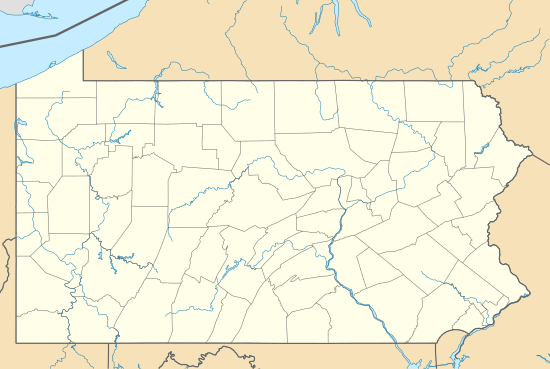  | |
| Location |
1 E. Germantown Pike, Plymouth Meeting, Whitemarsh Township, Pennsylvania |
|---|---|
| Coordinates | 40°6′10″N 75°16′41″W / 40.10278°N 75.27806°WCoordinates: 40°6′10″N 75°16′41″W / 40.10278°N 75.27806°W |
| Area | 9 acres (3.6 ha) |
| Built | 1767, c.1795, 1856 |
| Built by |
Samuel Maulsby (house & barn) George Corson (Abolition Hall) |
| Architectural style | Federal |
| NRHP Reference # | 71000713[1] |
| Significant dates | |
| Added to NRHP | February 18, 1971 |
| Designated PHMC | November 18, 2000[2] |
Hovenden House, Barn and Abolition Hall is a group of historic buildings in Plymouth Meeting, Whitemarsh Township, Montgomery County, Pennsylvania. The property was an important station on the Underground Railroad. Abolition Hall served as a meeting place for abolitionists, and later as the studio of artist Thomas Hovenden.
The house is located at the northeast corner of Germantown and Butler Pikes, opposite the Plymouth Friends Meetinghouse. Northeast of the house is the stone barn, and attached to the barn's east wall is the 2-story carriage house known as Abolition Hall. The three buildings are part of a 10.45-acre farm, and are contributing properties in the Plymouth Meeting Historic District.[3]
History
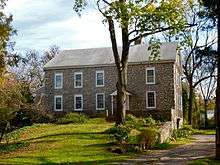 Maulsby Barn (built c.1795) Maulsby Barn (built c.1795) | |
|
|
A 2-story stone house was built at the corner of Germantown and Butler Pikes in 1767.[5] Samuel Maulsby (1768–1838)[6] purchased the house on 126 acres (51 hectares) in February 1794,[7] and established quarries and a lime-making business.[8] He enlarged the house into a 3-story, 14-room, Federal-style dwelling, built the stone barn (c.1795),[9] and is presumed to have built the carriage shed.[3] He married Susanna Thomas (1780–1818), and they had seven children.[10] Their daughter Martha (1807–1870) married George Corson (1803-1860) in 1832.[11] Maulsby died in 1838, and the couple purchased the farm from his estate the following year.[3] George and his brothers bought the quarries, and founded what became G. & W.H. Corson Company - Lime Merchants.[12]
Abolitionism
The Fugitive Slave Act of 1793 made it a federal crime to give assistance to an escaped slave.
"The earliest and only abolitionists in Plymouth and Whitemarsh townships were Samuel Maulsby, Joseph Corson and Alan W. Corson. Away back before 1820 they had been stirred by the scathing denunciations of slavery, and the horrors of the slave trade, made by Granville Sharp, William Wilberforce and Thomas Fouell Buxton, before the Parliament of Great Britain, to an intense hatred of slavery and the slave trade, and the abominations of slavery in our own country."[13]
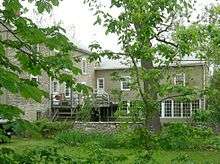
The families of both George and Martha Maulsby Corson had sheltered escaped slaves.[11] But it was the couple's close friendship with Benjamin Lundy – publisher of the Pennsylvania Anti-Slavery Society's weekly newspaper, The National Enquirer (1836–38) – that inspired them to fully engage in the cause.[11] They turned their property into a major station on the Underground Railroad,[lower-alpha 1] providing food and shelter to hundreds of escaped slaves.[15] From there fugitives were led by night to the next station[16] — northwest to the house of Daniel Ross, a free black man in Norristown, Pennsylvania;[17] north to the house of William Foulke at Penllyn, Pennsylvania; or northeast to abolitionists in Upper Dublin[18] and Horsham, Pennsylvania.[19] The routes continued through Bucks County, New Jersey and New York, and to eventual freedom in Canada.[20] In some instances, Corson hid people under a wagonload of hay and drove them to the next station.[3]
"The greater burden of the work [of sheltering runaways] was borne by George and his wife, Martha Maulsby Corson. Their residence in the old Maulsby home, right in front of the Friends' Plymouth Meeting-House, was so prominent a place, known by everybody for miles around, made it easy for slaves to find the place, when sent by those from a distance to 'George Corson's at Plymouth Meeting.' He it was who forwarded fugitives to Mahlon Linton, at Newtown, or to William H. Johnson, at Buckingham, or to Richard Moore, at Quakertown, Bucks county, time after time, during the whole period of the great struggle from 1830 to 1850."[13]
The Fugitive Slave Act of 1850 increased the penalties for giving assistance to an escaped slave to six months in prison and a $1,000 fine. It allowed slavecatchers to pursue a fugitive across state lines into every U.S. state and territory. Corson was involved in hiding Jane Johnson, whose escape exposed a loophole in the federal law.[21]
| “ | George Corson, who knew no fear when in the right.[13] | ” |
Jane Johnson
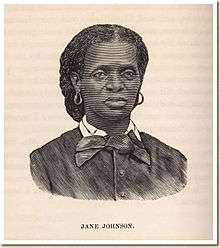
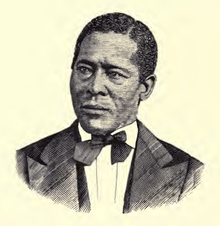
On the morning of July 18, 1855, Jane Johnson (c.1822–1872) and her two young sons arrived in Philadelphia by train with her master, North Carolina slaveholder John H. Wheeler, and his family.[22] They were en route from Washington, D.C. to New York City, and had to switch to a ferry to cross the Delaware River. Wheeler locked Johnson and her sons in a hotel room while he and his family took the afternoon to tour the city. Pennsylvania did not recognize the property rights of slaveholders, and Johnson sought help from a hotel porter in escaping from slavery.[21] The porter contacted abolitionist William Still, and Still and lawyer Passmore Williamson rushed to the docks as the Wheeler party was about to depart on a 5:00 pm ferry to Camden, New Jersey.[21] Williamson explained to Johnson that Pennsylvania law guaranteed freedom to her, if she chose it.[21] As Still led Johnson and her sons away, five black dockhands prevented Wheeler from stopping them.[lower-alpha 2]
Williamson, the only white man involved, was arrested and charged with violating the Fugitive Slave Act.[lower-alpha 3] Federal Judge John Kintzing Kane presided over his trial, and refused to believe that Williamson did not know where Johnson was being hidden. The judge found him in contempt of court, and jailed him for more than three months, which attracted national attention.[23] Williamson's successful defense was that Johnson's master had brought her into Pennsylvania, a free state, therefore she was not a fugitive across state lines, and state law rather than federal law applied.[24] Still and the five other men were charged with forcible abduction, rioting, disorderly conduct, and assault. On August 29, 1855, Johnson appeared as a surprise witness at their trial, and testified that she had voluntarily walked away from Wheeler. The most serious charges against the men were dismissed, although the two who had restrained Wheeler were convicted of assault and spent a week in jail.[21] Johnson was escorted out of the courthouse by Lucretia Mott, Rev. James Miller McKim and George Corson.[25] She was hidden at Corson's house in Plymouth Meeting to prevent pro-slavery activists from abducting her and returning her to slavery.[lower-alpha 4] At the end of her stay, Corson's young son Ellwood, (whose granddaughter, Nancy Corson, would reside at the homestead from 1946 until her death in 2012 ), drove Johnson in a carriage by night to Mahlon Linton's house in Newtown, Pennsylvania.[23] [26]From there she was smuggled to Boston, Massachusetts and reunited with her sons.[21]
Abolition Hall
The Plymouth Friends Meeting had permitted abolitionist speakers to use their meetinghouse for decades.[27] But, following the national controversy of the Jane Johnson affair – largely cheered in the North, viciously condemned in the South[21] – and in the heated political climate of 1856, permission was refused.[28] Corson's response was to add a second story to his carriage shed, and use that space as his own meeting room.
"[Corson] determined to build a hall, over which he could have control. He made quite a large one and furnished it well with seats, warmed and lighted at his own expense. And now we can see how convenient it was for the lecturers to make his house their temporary home. As time wore on more and more neighbors and friends were attracted to the meetings to hear the eloquent and earnest men and women who pictured the atrocities of slavery."[27]
Abolition Hall could hold up to 200 people,[16] and was used for meetings of the Montgomery County Anti-Slavery Society – of which Corson had been a founder in 1837 – and for lectures by prominent abolitionists, including Frederick Douglass,[29] Harriet Beecher Stowe, William Lloyd Garrison and Lucretia Mott.[30]
Corson died in November 1860. William Still eulogized Corson in his 1872 history of the Underground Railroad:
"There were perhaps few more devoted men than George Corson to the interests of the oppressed everywhere. The slave, fleeing from his master, ever found a home with him, and felt while there that no slave-hunter would get him away until every means of protection should fail. His home was always open to entertain the anti-slavery advocates, and being warmly supported in the cause by his excellent wife, everything which they could do to make their guests comfortable was done. It is to be regretted that he died before the emancipation of the slaves, which he had so long labored for, arrived."[31]
Artist's studio

The Corsons' daughter Helen (1846-1935), trained as an artist at the Philadelphia School of Design for Women and the Pennsylvania Academy of the Fine Arts. She further studied in Paris, and exhibited at the Paris Salon, 1876, 1879 and 1880.[32] She met Irish-born painter Thomas Hovenden (1840-1895) in France, and they were married at the Plymouth Friends Meetinghouse on June 9, 1881.[11] They moved into her late parents' house, and raised two children, Thomas Jr. and Martha.
Hovenden succeeded Thomas Eakins as Professor of Painting at the Pennsylvania Academy of the Fine Arts in 1886.[33] He specialized in genre scenes of rural life, using his neighbors, often African Americans, as models.[16] He converted Abolition Hall into a studio,[3] and the moral causes that had been championed there inspired some of his works.[34] His most famous painting – The Last Moments of John Brown (1882–84), Metropolitan Museum of Art – depicts the radical abolitionist John Brown kissing a baby as he is led to the gallows. Hovenden was elected a member of the National Academy of Design in 1881, and an academician in 1882.[33] In August 1895, he died after alighting from the Roxborough Chestnut Hill Norristown Trolley. Traveling south/east from Norristown, the trolley stopped at the grade-level tracks of the Plymouth Branch of the Reading Railroad (near what is now Chemical Road). To continue their journey, trolley passengers had to step off the trolley, cross the tracks, and board a waiting trolley that had arrived from the direction of Philadelphia. It was in crossing those tracks that he lost his life. His wife's advocacy resulted in the construction of an overpass above Germantown Pike, which raised the level of the train tracks and eliminated the dangerous pedestrian crossing. Rev. William Henry Furness gave the eulogy at his funeral, and Eakins and Samuel Murray were among the pall bearers.[35]
Helen Corson Hovenden was noted for her portraits of children and pets.[36] The couple's daughter, Martha Maulsby Hovenden (1884-1941), a sculptor, later used Abolition Hall as her studio.[11] Examples of her work can be seen at the Washington Memorial Chapel in Valley Forge. In 1939, Martha designed a bookplate, which is still in use by the Friends of the William Jeanes Memorial Library. The copper printing plate and original print of that bookplate are stored in the Friends archives.
Plymouth Meeting Historic District
In 1971, the Village of Plymouth Meeting became Pennsylvania's first National Register District. This followed the 1961 local historic district designation by a joint resolution of Plymouth and Whitemarsh Townships. In 1961, the local district included 66 historic structures. In 1971, Hovenden House, Barn and Abolition Hall were listed as a unit on the National Register, along with four other structures from among the 66.[37] In September 2016, the Pennsylvania Historical and Museum Commission issued a letter to Plymouth and Whitemarsh Townships clarifying and reiterating the significance of the Maulsby/Corson/Hovenden homestead, noting the "inter-related complex of buildings." The letter goes on to state that their 1971 nomination to the National Register of Historic Places "reinforces the important role that these buildings played within the context of the village, as well as their individual historical and architectural significance." [38]
Historical marker
Following the nomination prepared by Nancy Corson (1920-2012), great-granddaughter of George Corson, and Charles Blockson, an authority on the history of the Underground Railroad, a Pennsylvania state historical marker was dedicated at 4006 Butler Pike (in front of the barn) on November 18, 2000:[5]
ABOLITION HALL
The Antislavery meeting hall here, opened
in 1856, brought many leading abolitionist
speakers as guests of George Corson and
his wife, Martha Maulsby Corson. Built
over a carriage shed, the hall could ac-
comodate up to 200 visitors. The family's
1767 homestead here had already long been
a station on the Underground Railroad.
Later, 1881-1895, Abolition Hall was the
studio of son-in-law Thomas Hovenden, who
painted "Last Moments of John Brown."[39]
In mid-May 2016, a contractor working for Pennsylvania's Historical Marker Program removed the Abolition Hall marker for routine maintenance. In early September 2016, the refurbished marker was restored to its perch, roadside at 4006 Butler Pike, Plymouth Meeting, PA. Its west face catches the late afternoon sun.
Subdivision
A 2014 offer by Whitemarsh Township to purchase the property for open space was declined by its owners.[40]
In late 2015, K. Hovnanian Builders submitted a sketch plan to the township's planning/zoning office that included the re-routing of Butler Pike between the Hovenden House and the Barn/Abolition Hall.[41] The plan proposed the construction of 48 townhouses on the eight acres of open space behind the buildings.[42] Following vocal opposition, the Whitemarsh Township Board of Supervisors unanimously voted to oppose the developer's request for a zoning variance. In response, the developer requested a continuance of a scheduled April 25, 2016 zoning hearing.[43] In late August 2016, K. Hovnanian Builders submitted a revised Zoning Plan to Whitemarsh Township, asserting that this plan meets the requirements for shared parking and access (with an adjacent property). In early November, 2016, the Zoning Officer issued his Preliminary Opinion, concurring with the developer's assertion that the current Zoning Plan meets the requirements of the code. With the second publication of this opinion, a 30-day period begins during which any "aggrieved" party can file an appeal. Absent such appeal, the Zoning Officer's opinion becomes binding.[44] (See Section 916.2--Preliminary Opinion of the Zoning Officer)
In the spring of 2016, the Preservation Alliance for Greater Philadelphia accepted the nomination of Abolition Hall/Barn and Hovenden House for listing in its "Places to Save" registry, which "focuses attention and energy towards special places at risk of being lost, and is driven by the Preservation Alliance’s advocacy agenda. The sites are featured in each issue of Extant..." You can read the journal article here: http://mydigitalpublication.com/publication/?i=326306&p=14.
The Plymouth Meeting Country Store and Post Office (built c.1827), at 3-5 E. Germantown Pike, is also listed on the National Register.[37] In a recent TV news story, the current owner of the former General Store/Post Office took the news crew into the cellar and showed them the tunnels he says were used as part of the Underground Railroad. These tunnels lead to Abolition Hall, directly behind his building.[45] The proposed re-routing of Butler Pike would require its relocation or demolition.
See also
Notes
- ↑ Robert R. Corson: "While at Uncle George [Corson]'s a slave would knock at the door after dark, be taken in and cared for till next day in the evening, when he would be taken on to Bucks county. At that time our first, great duty was to secure their escape from the slave-hunters, so kept no account of the number of slaves or their history. Sometimes two or three men would come together—at other times women and children, or a man and wife. All were received and well cared for."[14]
- ↑ The dockhands were John Ballard, James P. Braddock, William Curtis, James Martin and Isaac Moore.[21]
- ↑ Judge John Kintzing Kane: "Of all the parties to the act of violence, he [Williamson] was the only white man, the only citizen, the only individual having recognized political rights, the only person whose social training could certainly interpret either his own duties or the rights of others, under the constitution of the land."[21]
- ↑ "The following night, in a close carriage, she [Johnson] was brought to the house of George Corson, at Plymouth Meeting, where for a few days in privacy, she received the kind ministrations of Martha Maulsby Corson, wife of George, and one of the earliest and most devoted of the abolitionists of the region."[23]
References
- ↑ National Park Service (2010-07-09). "National Register Information System". National Register of Historic Places. National Park Service.
- ↑ "PHMC Historical Markers". Historical Marker Database. Pennsylvania Historical & Museum Commission. Retrieved December 10, 2013.
- 1 2 3 4 5 "National Historic Landmarks & National Register of Historic Places in Pennsylvania" (Searchable database). CRGIS: Cultural Resources Geographic Information System. Note: This includes Nancy Corson (April 1969). "National Register of Historic Places Inventory Nomination Form: Hovenden House, Barn and Abolition Hall" (PDF). Retrieved 2012-04-21.
- ↑ "History at the Crossroads, The Activists and Artists of Abolition Hall". PFW Media. Retrieved December 2, 2016.
- 1 2 "Abolition Hall (Thomas Hovenden) Historical Marker," from Explore PA History. NOTE: The article gets some of the dates wrong, and mistakes the barn for the carriage house.
- ↑ Maulsby-Albertson Family Papers, from Swarthmore College.
- ↑ Montgomery County Deed Book #9, page 180.
- ↑ Limestone was burned in kilns to produce lime, which was mixed with sand to create mortar.
- ↑ Hovenden House, Barn and Abolition Hall, from Philadelphia Architects and Buildings.
- ↑ Elwood Roberts, Plymouth Meeting: Its Establishment, and The Settlement Of The Township, (Norristown, PA: Roberts Publishing Company, 1900).
- 1 2 3 4 5 Hiram Corson, M.D. "George Corson," The Corson Family: A History of the Descendants of Benjamin Corson, Son of Cornelius Corssen of Staten Island, New York. (Philadelphia: H.L. Everett, 1906), pp. 112-17.
- ↑ Cold Point Historic District, from LivingPlaces.com.
- 1 2 3 Hiram Corson, M.D. "The Plymouth Group," The Abolitionists of Montgomery County, (Norristown, PA: Historical Society of Montgomery County, 1900), pp. 41-43.
- ↑ Hiram Corson, M.D. "Norristown Group," The Abolitionists of Montgomery County, (Norristown, PA: Historical Society of Montgomery County, 1900), p. 35.
- ↑ Thomas Hovenden: American Painter of Hearth and Homeland, Woodmere Art Museum, Philadelphia, 1995. ISBN 1-888008-00-8.
- 1 2 3 Ron Avery, "Plymouth Meeting Quakers Hid Slaves – It's A Shrine Of The Underground Railroad," The Philadelphia Inquirer, June 19, 1995.
- ↑ William Still, The Underground Rail Road (Philadelphia: Porter & Coates, 1872), p. 723.
- ↑ Annette John-Hall, "An underground story no more," The Philadelphia Inquirer, December 14, 20012.
- ↑ Hiram Corson, M.D. "Upper Dublin and Horsham," The Abolitionists of Montgomery County, (Norristown, PA: Historical Society of Montgomery County, 1900), p. 44.
- ↑ William J. Switala, Underground Railroad in Pennsylvania, (Stackpole Books, 2001), pp. 160-61.
- 1 2 3 4 5 6 7 8 9 Phil Lapsansky, "The Liberation of Jane Johnson," The Library Company of Philadelphia, 2003.
- ↑ Jane Johnson, from American National Biography.
- 1 2 3 Hiram Corson, M.D. "The case of Jane Johnson and her boys of seven and eleven years," The Abolitionists of Montgomery County, (Norristown, PA: Historical Society of Montgomery County, 1900), p. 26.
- ↑ Narrative of the Facts of the Case of Passmore Williamson (1855), from Library Company of Philadelphia.
- ↑ William Still, The Underground Rail Road (Philadelphia: Porter & Coates, 1872), p. 96.
- ↑ Friends' Intelligencer and Journal. Friends' Intelligencer Association. 1898-01-01.
- 1 2 Theodore Weber Bean, "The Corson Family," History of Montgomery County, Pennsylvania, Volume 2, (Unigraphic, 1884), pp. 1036-37.
- ↑ Anne Gregory Terhune et al., Thomas Hovenden, His Life and Art, (University of Pennsylvania Press, 2013), p. 101.
- ↑ Melia Bowie, "Historical marker for a carriage shed called Abolition Hall," The Philadelphia Inquirer, December 10, 2000.
- ↑ Helen Reichart Mirras (December 1969). "National Register of Historic Places Inventory Nomination Form: Plymouth Friends Meetinghouse" (PDF). Retrieved 2015-06-18.
- ↑ William Still, The Underground Rail Road (Philadelphia: Porter & Coates, 1872), p. 721.
- ↑ "Helen Corson Hovenden," from Art Price.
- 1 2 "Thomas Hovenden, 1840 – 1895," from National Academy of Design.
- ↑ Lee M. Edwards, "Noble Domesticity: The Paintings of Thomas Hovenden," American Art Journal:19 (1987): 5-38.
- ↑ Ernest Pfattiecher, "Thomas Hovenden," The Book News Monthly, vol. 5, no. 25 (January 1907), p. 305.
- ↑ Martha Hovenden and Her Dog (1888), from Woodmere Art Museum.
- 1 2 Brian Coll, "The intersection at Butler Pike and Germantown Pike could change as well as the entire landscape," Conshystuff, April 8, 2016.
- ↑ September 8, 2016 letter from the Pennsylvania State Historic Preservation Office re Plymouth Meeting National Historic Register District
- ↑ "Abolition Hall," from Waymarking.
- ↑ Kristin E. Holmes, "Coexistence sought for Underground Railroad site and townhouses," The Philadelphia Inquirer, May 9, 2016.
- ↑ Sydelle Zove, "Underground Railroad site threatened," The Philadelphia Inquirer, April 20, 2016.
- ↑ Subdivision sketch plan for Whitemarsh Corson Estate, from Hidden City Philadelphia.
- ↑ Michael Bixler, "Historic estate and Underground Railroad station under threat in Plymouth Meeting," Hidden City Philadelphia, April 20, 2016.
- ↑ http://dced.pa.gov/download/pennsylvania-municipalities-planning-code-act-247-of-1968/#.WBQJvy0rKpo
- ↑ http://www.nbcphiladelphia.com/news/local/Battle-Over-Sacred-Ground-in-Montgomery-County-With-Ties-to-Underground-Railroad_Philadelphia-378487706.html NBC10 story, "Battle Over Montco's Ties to the Underground Railroad."
| Wikimedia Commons has media related to Hovenden House, Barn and Abolition Hall. |


